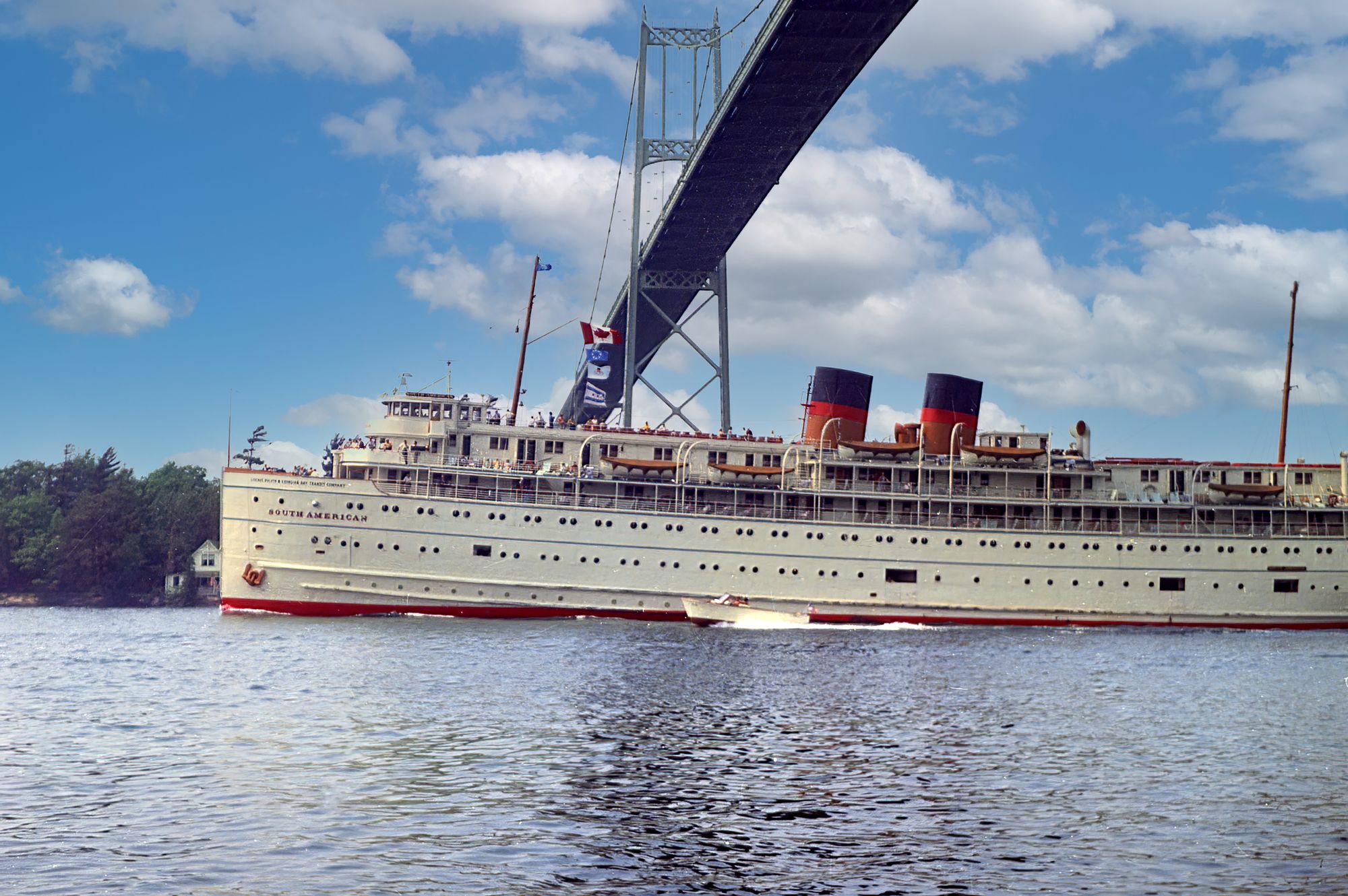SS South American, a 321-foot overnight Great Lakes passenger steamer, did not normally ply the waters of the St Lawrence River. Her realm was the waters of Lakes Superior, Michigan, Huron, and Erie. South American was also known for its high school voyages during the 1950s. Seniors from high schools in southeastern Michigan would take the small cruise from Detroit to Chicago. Yet perhaps her most successful season was the summer of 1967, when she departed her regular schedule and made 18 cruises from Great Lakes ports, down the St Lawrence to Montreal, QC, carrying thousands of passengers to the 1967 International and Universal Exposition or Expo 67, as it was known.
From the late 19th century to the mid-20th century, leisure cruising on the Great Lakes enjoyed great popularity. The Chicago, Duluth & Georgian Bay Transit Company (later known as just the Georgian Bay Line) was founded by Robert C. Davis in 1913. Mr. Davis envisioned a fleet of ships dedicated exclusively to passengers, rather than the passenger and freight ships that were currently sailing the inland sea. The company began operation with the launching of the SS North American on January 16, 1913. The first season was so profitable that the company launched its second ship, the SS South American, on February 21, 1914. The two ships, with steel hulls and wooden superstructures, were almost identical except that the North American was almost 40 feet shorter.

Known as the "Queen of the Inland Seas", the South American was built in 1913 by the Great Lakes Engineering Works, on the shore of the Detroit River, at Ecorse, MI. She was constructed as a coal-burning steamer with berths for 500 passengers and a crew of 165. Powered by a 2,200-horsepower quadruple-expansion steam engine and three coal-burning Scotch marine boilers, she was 321 feet in length, with a 47-foot beam, an 18-foot draft, and displaced 2,662 tons.
The Georgian Bay Line operated a scheduled passenger service with North American and South American from Buffalo to Cleveland, Detroit, Mackinac Island, Thunder Bay, and Chicago.
Fire
Each winter, the ships were laid up at the Lake Macatawa docks at the foot of West 16th Street in Holland, MI. On the night of September 9, 1924, fire broke out aboard South American. The fire spread quickly throughout the ship. While the superstructure was destroyed, the hull was saved when an engineer flooded the hold and partially submerged the ship. Repaired by its original builder, the Great Lakes Engineering Works, South American was ready in time for the 1925 season. A second smokestack was added, and her coal-fired boilers were converted to oil-burning.
Automobiles
Following World War II, pent-up demand for new automobiles, inexpensive gasoline, and rapidly expanding highway systems cut deeply into the point-to-point passenger demand. As a result, the Georgia Bay Line shifted its emphasis to being a cruise line. Business boomed in the 1950s. The Great Lakes cruise was extremely popular.
Air Travel
But the Georgian Bay Line lost money in the 1960s. Great Lakes cruising was curtailed in the winter months, and with viable, commercial air travel, passengers could fly to southern ports for excursions to Caribbean ports-of-call.
In 1963, the Georgian Bay Line retired the North American. She had run aground in the St Lawrence in 1961 and lost some of her popularity with the public. The South American and the Greene Line's Delta Queen were the last two long-distance cruise ships sailing under the U.S. flag, but neither ship could meet modern fire-safety standards.
Sinking
North American was sold to the Seafarers International Union in Piney Point, on the shores of the Potomac River in Maryland, for further use as a training ship. The ship was being towed by the tug Michael McAllister to a shipyard in Newport News, Va., for conversion when it sank suddenly on the night of September 13th, 1967. Swells from approaching Hurricane Doria proved too much for the aging ship and contributed to her loss. The North American sank in the Atlantic approximately 140 miles off the New England coast in 250 feet of water. No one was injured in the sinking and the tug reached port safely.
In 1966, citing the danger to passengers of a catastrophic fire in ships with wooden superstructures, Congress enacted a law ordering both ships to be permanently docked and out of service. A series of temporary exceptions were carved out for the South American, but not for the Delta Queen.
Last season and Expo '67
Thus, in 1967, South American was making voyages to Expo 67, in Montreal, cruising up and down the St Lawrence. At the end of the season, she was retired from regular passenger service and sold to Seafarers International as a replacement for the North American. Failing Coast Guard inspection, she was moved to Camden, NJ, where she rotted before being scrapped in 1992 at Baltimore.
By Alan Goldstein
Alan Goldstein hails from Watertown, NY. He served 26 years in the US Navy. TI Life featured his photographs and his bio in August 2021 in Meet Alan Goldstein, Photographer. After retiring in 1994 from the US Navy, he began creating the Navy's signature webpages, as the first US Navy Webmaster!
Posted in: Volume 17, Issue 4, April 2022, History
Please click here if you are unable to post your comment.
